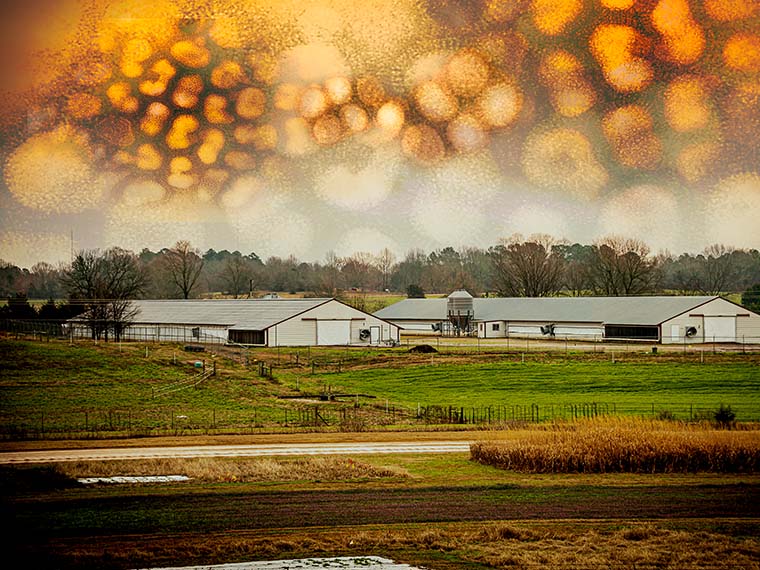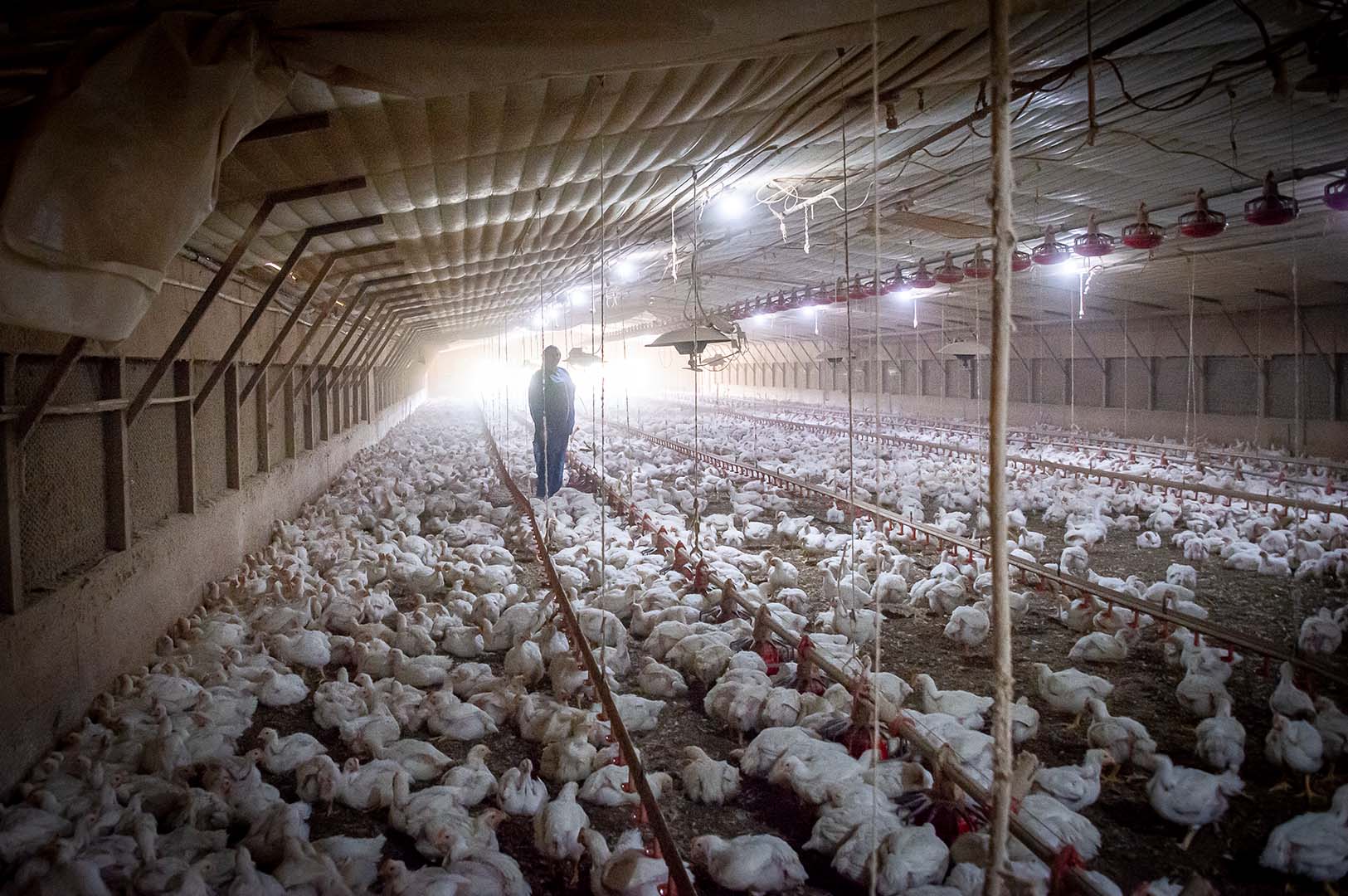The information presented on this page may be dated. It may refer to situations which have changed or people who are no longer affiliated with the university. It is archived as part of Mississippi State University's history.
In 2015, avian influenza grounded much of a soaring poultry industry. The pathogen persisted, leading to a total economic loss of $3.3 billion. The outbreak ultimately impacted more than 50 million birds on 232 farms across 15 states.
While biosecurity measures were immediately adopted on farms with infected flocks to eliminate bird-to-bird spread and surface contamination, transmission persisted. Strict biosecurity measures were implemented to protect flocks including control over access to flocks by vehicles, people, and equipment; avoidance of introducing birds of unknown disease status into the flock population, and much more. Infections were addressed by depopulating the flock quickly and completely sanitizing the facility. When that didn't completely stop the spread, poultry researchers wondered if an answer to the virus's transmission might come from above.
Dr. Yang Zhao, assistant professor in the Department of Agricultural and Biological Engineering and MAFES scientist, along with collaborators from Iowa State University, the University of Georgia, and the University of Tennessee, employed a meteorological model in a novel way to track the airborne journey of the avian flu virus from one infected farm to another. Zhao and collaborators tracked the outbreak across Iowa, the country's largest egg producing state and the epicenter of the outbreak. The team assessed the possible role airborne transmission played in the spread of the pathogen in hopes of developing best practices producers could adopt to mitigate future risk.
"That direct contact restriction wasn't sufficient in stopping the disease coupled with the anecdotal evidence that abnormally higher bird mortality started near air inlets of the infected houses led us to explore whether or not airborne transmission was possible," Zhao explained.
The team used a hybrid single particle integrated trajectory model developed by the National Oceanic and Atmospheric Administration, or NOAA, and the Australian Bureau of Meteorology.
"This model uses big data sets from many meteorological stations to model the transport of gas pollutants, airborne dust, and airborne pathogens," Zhao said.
The researchers loaded information from 232 farms across the U.S. including farm location, infection day, depopulation day, and the number of birds at each site into the model to evaluate possible airborne transmission from farm to farm.
Zhao explained that while the model had limitations for tracking airborne transmission of viruses, the team was able to garner information that proved beneficial to poultry producers. Two challenges included the model's resolution and the nature of the flu itself.
"Since this is a meteorological model, the highest resolution is 12 kilometers, or about seven and a half miles, so we can only track the trajectory from one farm to neighboring farms more than seven miles away," said Zhao, who noted collecting air samples was the best way to determine airborne transmission over short distances.
Zhao explained the model's second limitation was the survival of virus in the air. He said while the flu experts provided estimations on the virus survivability; these estimations have not been experimentally validated.
He continued, "Additionally, the model assumes the virus spreads uniformly in the air, but in reality it attaches to a dust particle so poultry catching the virus is less predictable."
Despite the limitations, researchers were able to use the model's backward trajectory and starting at the end point or last poultry house infected, they could picture how transmission was possible from farm to farm.
Of the 77 farms in Iowa infected with avian influenza, the team determined the majority of the positive cases might have received airborne virus, carried by fine particulate matter, from an infected farm within the state and in neighboring states.
"We found in the worst-case scenario, which would include maximum virus shedding rate, highest emission rate, and longest half-life of the virus, 33 Iowa farms had more than a ten percent probability of infection via airborne transmission, while three farms, in particular, had a greater than 50 percent probability of airborne-transmitted infection," Zhao said.
Zhao said he's most excited that the information led to practical application producers can employ to reduce their risk should another outbreak occur.
"We are happy to find something that can help the producers. While we can't conclude firmly that the virus transmits through the air, we can say it's possible. Many producers saw this research and said so long as this is possible I am going to protect my farm," Zhao said.
Some producers installed inlet air filtration with electrostatic precipitation to catch viruses that come into the poultry house. The researchers measured the viral removal efficiency of that particular system, estimating that it does remove 75 percent of virus particles. Additionally, the research found if producers depopulate their infected flocks within 24 hours and turn off the ventilation, the likelihood of disease spreading through air can be significantly reduced.
"We found if virus emissions from infected flocks can be stopped within 24 hours and producers use the inlet air filtration system with electrostatic precipitation, the risk of infecting healthy flocks through airborne transmission can be extremely low," he said.
The team pointed out that this new found knowledge could impact where poultry producers build new houses, using data as a way to protect their own houses and those of their neighbors.
Dr. Hongwei Xin, now dean of AgResearch, the University of Tennessee Institute of Agriculture, served as the project's principal investigator. He said the research provided a chance to see the big picture when it comes to the possibility of airborne transmission of avian influenza.
"We know mechanical transmission, for example bird-to-bird infection and people moving from house to house without proper biosecurity measures in place, was the main mode of viral spread, but you can't rule out the possibility of airborne transmission," Xin said.
He continued, "We now have a tool that can potentially aid us in predicting the airborne spread of this virus, something that would be either extremely challenging or impossible to predict with physical measurements. We now can look at one poultry house and say how it might infect a house down the road."
Xin pointed out that the study shows the importance of thinking about how human health, animal health, and the environment are intertwined. A global initiative known as One Health promotes this system approach to studying health on a broader scale.
This past February, in his role as dean and director of AgResearch, Xin helped spearhead the launch of the University of Tennessee's (UT) One Health Initiative, or UTOHI, which is an effort to enhance collaborative research that addresses emerging health challenges across the region and state of Tennessee. A similar One Health Initiative was also adopted by MSU's College of Veterinary Medicine.
"When we launched UTOHI in February, we didn't know the situation our world would be in today with the global pandemic caused by the coronavirus. However, this concept of One Health couldn't be timelier. UTOHI has a team working diligently to address all the challenges we're facing today," Xin said.
Xin said while the particular strain of avian influenza that resulted in the 2015 outbreak wasn't zoonotic, meaning that particular strain did not infect humans, other strains of avian influenza have infected humans.
"The virus in the U.S. in 2015 was HPAI H5N2, but a different strain called HPAI H5N1 has caused human infection since 2003 with an outbreak impacting approximately 500 people in Hong Kong in 2010," he noted.
Even though the virus in 2015 didn't infect humans, it still affected them considerably, Xin said.
"The 2015 avian influenza outbreak impacted poultry producers but it also impacted small businesses and consumers," Xin said. "This outbreak became a food security issue because it caused an egg shortage, which tripled the price of eggs. Some restaurants had to close for breakfast because they couldn't get enough eggs while grocery stores in certain places limited the purchase of eggs to only two cartons at a time."
As the U.S. experiences disruption in its food supply chain because of the current pandemic, Xin said this particular study is an example of the first step in understanding how a virus can impact humans, animals, and the environment.
He pointed out that when a virus-whether it's avian influenza in 2015 or coronavirus in 2020-impacts our lives and disrupts the food chain, a critical step in food security is understanding how that virus is transmitted, noting that this particular research took the One Health approach.
"The importance of One Health to society cannot be overstated, and the contributions of agricultural and natural resources research along with studies and advances in veterinary medicine are core to advancing environmental health for the benefit of all living things," Xin said.
USDA-NIFA Exploratory Program (Award No. 2015-67030-24115) and the Egg Industry Center located at Iowa State University funded this research. Additional collaborators included the Iowa Department of Agriculture and Land Stewardship.
We found if virus emissions from infected flocks can be stopped within 24 hours and producers use the inlet air filtration system with electrostatic precipitation, the risk of infecting healthy flocks through airborne transmission can be extremely low.
Dr. Yang Zhao


